After the Selous, we went on to Kilwa. Kilwa is a tiny little town on the south east coast centered on one bay about ½ mile across. Three little motels surround the bay. We stayed at the north end one which was on a cliff overlooking the ocean. Like the tropics the buildings are simply a roof with no walls as it is always warm there. The rooms were a set of thatched roof A frame units. No hot water. Power on and off. But they have a generator if needed to light up a few lights. It is quite nice to sit in a warm ocean wind drinking a cold beer in the dark, but trying to sleep in the heat/humidity with no breeze nor air conditioning (not existent) nor ceiling fan (electricity was off!) The bar and dining tables were just one bigger room with a big baobab tree growing up through the center to support the thatched roof at the center. Bob Marley was going in the back ground. Only a couple of other folks there. Nice and simple but quite a nice place once there. Mzungus would be most of the business there it seems. As usual it was off the main road and no signs how to get to it or one half fallen down one. So you have to drive thru this set of local houses and streets to get to it hoping it is the right way. They just don’t get the power of marketing over here.
We got talking to 3 young guys from South Africa in a land cruiser also staying at the motel. They were on a heck of a trip between university years. The bought the landy to go on this 3 month trip. They left Jo’burg and are driving up the east coast of Mozambique, Tanzania and Kenya then crossing over to the west side of Kenya and coming back down through the rift valley and along the big lakes there, back thru Victoria falls into Zambia, then Botswana to S Africa again. Kilwa was their first stop in Tanzania coming out of Mozambique that morning. Kilwa is about 300 km from the border. Their trip through Mozambique was somewhat hair raising with high water levels across roads, no maps of many roads, they don’t speak Portuguese, they ran out of cash and the ATMs didn’t work. Sounds like in Northern Mozambique there are no roads anyway just trails through the scrub, the villagers are educated so poorly (as they are in TZ in places) they can’t read maps and don’t even understand the concept of a map, so these guys had a heck of time trying to get to the border crossing town. The Moz to TZ border is a wide river. There is meant to be a bridge, but it is gone, there is meant to be a ferry but it sank. So here they were enough gas for 200 km and about $300. The last gas place was about 200 km back in to Mozambique. They struck a deal with the local fishermen to make a raft by lashing three fishing boats together, put the cruiser on top of that and rowing across the river for $250. They thought Tz was a modern relief to enter after Mozambique!
For some unknown obvious reason the road down the SE cost of TZ is actually sealed once you are south of Kilwa. One of the past major politicians came from one of the town in the south so maybe that was the reason. The roads were made by the Japanese and were the best we had seen so far. So once at Kilwa we thought now that we are past that danged rough road and are on tarmac we might as well see the area more as we are unlikely to come this far south again and face that rough road again. So we went further down the coast from Kilwa to Linde then Mtwara near the Mozambique border as the South African guys had said the road was good all the way.
Kilwa is known as an old center of trade back in the 1500s under the Arab traders and sultans had built palaces and houses in the area. Then later the Portuguese had come and taken over and remodeled some of the buildings or built new ones. They are all mostly ruins now but a fascinating place to go explore to see these old structures. A couple had been restored by donors over the recent years. The best ruins are on an island off the shore about 2 miles. The island is called Kilwa Kisiwani. From Kilwa beach we caught a dhow sailing boat off the beach over to the island. We went with the other couple staying at the motel with us, an English couple who worked at the British High Commission, with their two teenage sons. We all went on the same tour of the island so got to chat with them quite a bit during the day. Nice couple with an interesting career. They get posted to various places around the world in various High commission offices for 3-4 years at a time. They moved in quite high circles in Tz, so knew most of the politicians, what TZ politics was doing and likes. It was quite interesting to talk with them.
The dhow is an interesting boat. It has a center mast but no sail attaches to it. The sail is triangular shape and the long side is tied to a long pole. If the dhow is going down wind this long pole is pulled up horizontally to the top of the mast with the sail below it, so it acts like a spinnaker and billows out to catch the wind. If the dhow has to sail up wind, the long pole is tied vertical against the mast pole to make a conventional shape sale so it can tack back and forth. There is only one pulley on the boat which is used to move the sail pole relative to the mast pole. No cleats either. All hand tied. Quite crude but it works and they sail all over the place there fishing and hauling stuff back and forth. We spent about 4 hours on the Island on the tour of the ruins. Must have taken over 100 pictures. There is one village of locals there where we stopped to get a coke as it was quite hot. There was a nearby water well with ladies dropping buckets about 30 ft down it to get water. Not 20 yards away was a hand pump over a bore that some NGO had installed fairly recently (with in 2 yrs) it looked like. There were kids there using it to pump water into plastic buckets. It is a lot easier and faster to get water from a hand pump then from a bucket down a well that may be polluted as well. So I asked the guide why the women still used the well and not the hand pump. He replied in a broken English manner that the hand pump water was salty so they could only use it to wash in, not for consumption, hence the need for the water well too! I wonder if the NGO knew this? Oh well, good intentions I expect. Made me thankful we had gotten a salinity meter for testing our wells.
After the ruins we went back on the dhow to the Kilwa beach and went to one of the other motels which was right on the beach for lunch with the English family. Downed two sodas in about 15 mins it was so hot. After lunch we were walking back along the beach to our motel and one of the fishing dhows had just beached and was cutting up a shark they had caught that morning. The English guy buys a big steak off them for $6 and takes it back to our motel and asked them to cook it up for them that night.
The next day we headed south down past a town called Linde then on to the last southern town before the Mozambique border called Mtwara. Another small fishing town really. The English family were headed down there too but stopping at a little town called Mikindani about 10 km short of Mtwara. There was a restored German Boma (Old administration building the Germans had built during their occupation of Tz in the first world war.) Now it was a beautiful old building on the side of a hill in amongst this set of typical TZ buildings making the rest of the town. We stopped there for lunch as it seemed quite nice. While there the English family showed up to check in as they were staying there. They said we should too. But we didn’t want to overstay our welcome with them, so we decided to go on to Mtwara. This is an interesting little town. Sort of on a peninsula so unlike Kilwa which was a few buildings along a small dirt road, Mtwara is more spread out all over the peninsula. We had made a reservation that morning based on a recommendation in the Lonely Planet. We found it on a dirt road on the ocean front. It too was basic but amazing it is right on the water, about 10 yards off the waves. Blue and turquoise waters across the bay to another peninsula. Dhows sailing back and forth in the afternoon winds made it very picturesque. A big open air dining/bar area. Like Kilwa though there are just not many tourists there. Had it been in the western world it would have been packed. We met and chatted to a few other Mzungus on the beach staying in the budget guest houses nearby. One was from Switzerland doing an electricians job way out west in the middle of nowhere it seemed. Then we met a girl from the Peace Corps and her boyfriend who had just flown in to spend time with her. She was quite young and doing some hard yards but seemed to be enjoying it. She was assigned to the same town as the Swiss guy turned out. She had no power, no water, had to fetch her own in buckets, cook over an open fire, dirt floor I would think, no transport other than a bus. Ramona and I both cringed.
The guide book said there was a store called Safina where you could buy a few nibbles like candy, biscuits and juice etc. We turned in to the road but could see no shop, it was like a drive way. Then backing up we realized the shop was old 20ft container with this old Dutch woman sitting outside of it. We went in there and sure enough there were the nibbles. She had been in Mtwara a long time she said. The next day as we drove down the main street of the town we realized almost all of the shops were old 20ft containers side by side with a bit of wooden front structure built around it. So the whole town was based on old containers, weird, never seen anything like it. But works it seems.
The guide book also said there was a church worth checking out as it was covered in paintings of biblical scenes to help the masses understand the sermons. It had taken some German painter in the 1800s 2 years to paint these. We found it down yet another dirt road amongst local houses and little shops. It was in quite good shape. Recently replastered and painted on the outside it looked like. Sure enough on the inside were these huge wall paintings. 5 on the left of the old testament, like Noah’s ark, One of Abraham, one of Moses on Mt Sinai getting the commandments. 5 on the right of thenew testament and 1 extra large one on each end. I took quite a few pictures as it was rather impressive to see this in such a place.
We left Mtwara before lunch and drive north back to Kilwa. Stopped there the night, had one last swim in that beautiful blue water. Then the next day headed back up that danged road, another 3 hours of 5 mph. But knowing that it was only 60 km this time and it had not rained for a few days made it a less unpleasant than the trip down.
Back in Dar for 4 days we went up north on the Msasani Peninsula where most of the ex pats lived. The English family we met had recommended a set of apartment suites there to stay. It was indeed a nice place called the Slipway. It is sort of a complex, the apartment suites, several nice restaurants on the water around a courtyard, a local craft market with budget to high end wares . Being New Years Eve there was a lot of activity going on there in the courtyard. A big 2009 sign in lights, a DJ playing modern Latin, then African then Indian music, people dancing. We sat at a pub’s outside table where we could watch the goings on and drank a good amount of cold wine and cold beer. A 5 minute fireworks display brought in the New Year & woke up to have a look at it from our room.
The next day we went to an island off shore that again our English friends had told us about. The boat left from near our apartment and took an hour to get to the island. It is a marine reserve, only about 1 km long covered in trees but surrounded by white sand and some coral reefs in places. We spent about 4 hours there doing a bush walk, a couple of swims on the reefs and then hiding out of the sun under a thatch beach stall/umbrella. It was quite hot. The water was so nice that once the boat pulled up off shore and we were to transfer to the dingy to be taken ashore I jumped over board and swam ashore as it wasn’t far. Clear blue waters again.
The 2nd of Jan we went to find a big shopping mall we’d been told about that was not too far away. After a few false trials we did find it. A big, big grocery store, a Kmart type store, a Target type store, book store, house wares stores, clothing stores. We were so happy to feel like home. There are a lot of food items we cannot get in Morogoro (town nearest to Gairo) so we stocked up large before heading back to Dar for our next 12 weeks in Gairo.
We also spent time in Dar trying to find where to get items for our engineering project in Gairo. We needed, ropes, fittings, a compressor etc, Dar has a few street names, but businesses don’t give an address only a PO box and phone number. The yellow pages is minimal, don’t even think about a website for a business. It is so difficult for someone to find suppliers. You’ll see a bill board with a business name and logo and ph number. But no address oh no!! Very frustrating and unnecessary in these times. You’d think businesses would be falling over themselves to get their wares promoted in the city. The only way to find anyone is to ask someone where to find it. Then you have to hope you ask the right person who speaks the same language as you do, or make sure you ask a wider range of people to find what you are looking for. One of the expats we met said even Tanzanians who come back from working overseas for a while find it frustrating to try to do business here.
By the time we got back to Gairo we had driven about 2500 km (1500 m). Plus the Pajero was bulging with items we bought back for the project such as the compressor, a QED pump and lots of tubing, our personal items, a bulk supply of food from the Dar stores. Barely enough room left for Ramona and myself.
Subscribe to:
Post Comments (Atom)
































































































































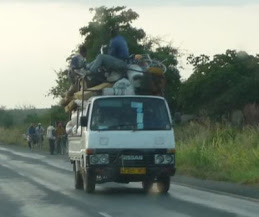





























































































































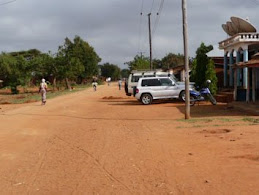

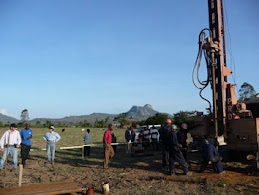


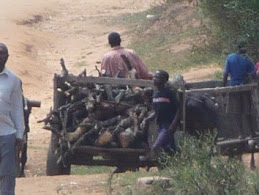
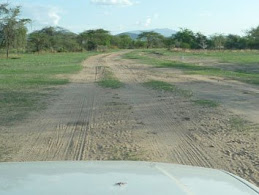























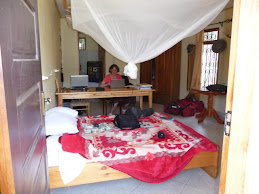

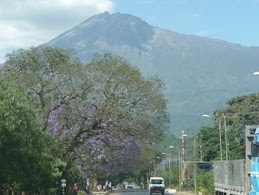
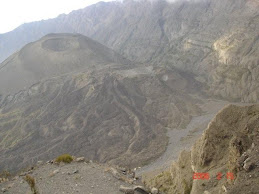
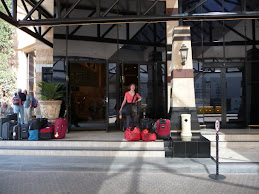
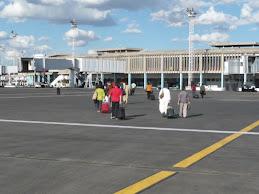
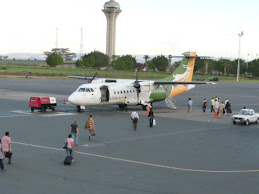
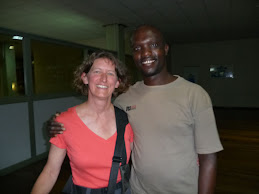
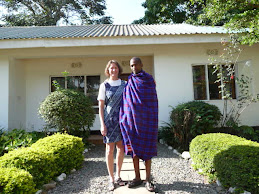
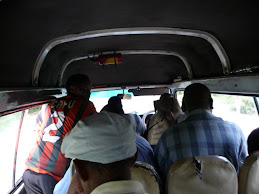


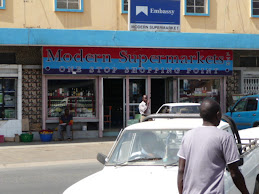





No comments:
Post a Comment